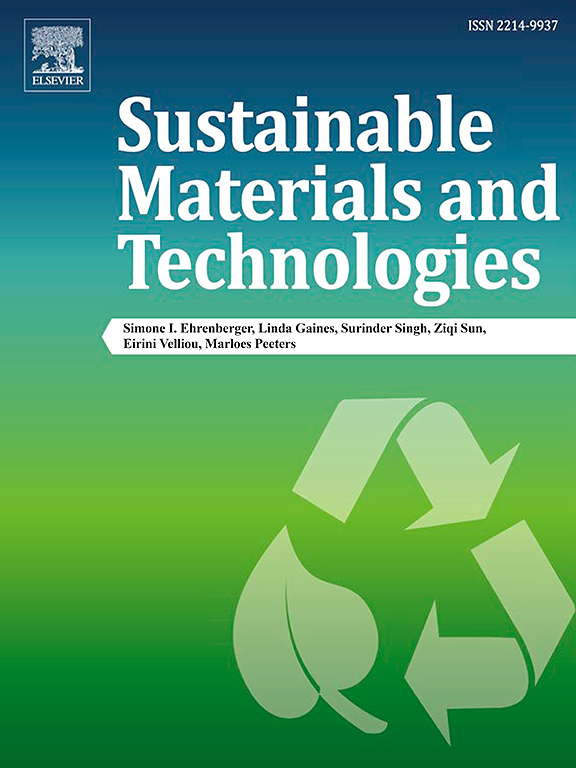通过分子扩展构建新型无金属 HCOF-Ph@g-C3N4异质结,提高光生载流子参与分子氧活化和光催化氢气进化的能力
IF 8.6
2区 工程技术
Q1 ENERGY & FUELS
引用次数: 0
摘要
对具有优异稳定性和可调结构的共价有机框架(COFs)进行改性是获得高效光催化剂的关键。本研究将超交联 COF-Ph 与 g-CN 构建成新型 HCOF-Ph@g-CN 异质结,并成功地将 g-CN 的片状介孔嵌入三维 HCOF-Ph 的孔隙中。该合成策略大大提高了催化剂的光催化性能和分子氧活化能力。10 mg HCOF-Ph@g-CN 异质结可在 14 min 内完全降解 30 mg/L 的四环素(TC),制氢速率达到 9214.69 μmol g h。此外,通过 3,3′,5,5′-四甲基联苯胺(TMB)氧化和氯化硝基四氮唑(NBT)降解实验,分别考察了异质结界面的分子氧活化能力和超氧自由基的产量。我们发现,分子扩张策略可以改变分子能带结构,从而改善对太阳光的吸收,而 g-CN 和 HCOF-Ph 的互补能带结构则保证了光生电荷的有效分离。这项研究为合成 COF 基催化剂提供了一种高效的分子扩增方法,在能源和环境领域具有潜在的用途。本文章由计算机程序翻译,如有差异,请以英文原文为准。
Constructing novel metal-free HCOF-Ph@g-C3N4 heterojunctions through molecular expansion to enhance photogenerated carrier involved molecular oxygen activation and photocatalytic hydrogen evolution
Modification of covalent organic frameworks (COFs) have exceptional stability as well as tunable structures is the key to efficient photocatalysts. In this study, hyper-crosslinked COF-Ph was constructed with g-CN to obtain a novel HCOF-Ph@g-CN heterojunction, and the lamellar mesoporous of g-CN was successfully embedded into the pores of 3D HCOF-Ph. The synthetic strategy greatly enhanced the photocatalytic properties and molecular oxygen activation capability of the catalyst. 10 mg of HCOF-Ph@g-CN heterojunction could completely degrade 30 mg/L of tetracycline (TC) within 14 min, and the rate of hydrogen generation reached 9214.69 μmol g h. The active species in this process of photocatalysis were verified through tests with free radical trapping and ESR spectra. In addition, the molecular oxygen activation capacity of heterojunction interface and the yield of superoxide radicals were examined by 3,3′,5,5′-tetramethylbenzidine (TMB) oxidation and degradation of nitrotetrazolium nlue chloride (NBT) experiments, respectively. We found that the molecular expansion strategy can change molecule energy band structure to improve absorption of sunlight, and the efficient segregation of the photogenerated charge were ensured by the complementary energy band structure between g-CN and HCOF-Ph. This study created an efficient molecular expansion method for the synthesis of COF-based catalysts with potential uses in the energy and environmental fields.
求助全文
通过发布文献求助,成功后即可免费获取论文全文。
去求助
来源期刊

Sustainable Materials and Technologies
Energy-Renewable Energy, Sustainability and the Environment
CiteScore
13.40
自引率
4.20%
发文量
158
审稿时长
45 days
期刊介绍:
Sustainable Materials and Technologies (SM&T), an international, cross-disciplinary, fully open access journal published by Elsevier, focuses on original full-length research articles and reviews. It covers applied or fundamental science of nano-, micro-, meso-, and macro-scale aspects of materials and technologies for sustainable development. SM&T gives special attention to contributions that bridge the knowledge gap between materials and system designs.
 求助内容:
求助内容: 应助结果提醒方式:
应助结果提醒方式:


